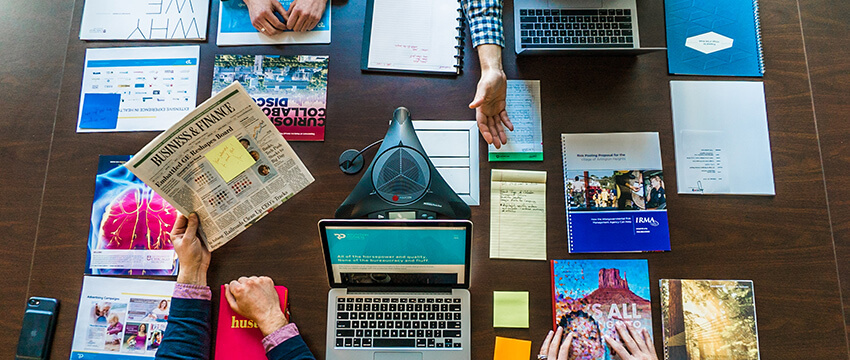Every brand interaction is designed. The only question is whether that design is effective or ineffective. Nick Quirke, SVP and director of creative services at RP, discusses graphic design, branding and marketing strategy from 2018. In addition, he discusses embracing change, avoiding pitfalls and getting the biggest return from your marketing budget in 2019.
What do you think has been the biggest trend in design in 2018?
The biggest trend I saw was a move toward simplification; a ‘less is more’ approach with a number of different goals. A few high-level brand refreshes illustrate this shift.
Dunkin’ Donuts shortened its name to Dunkin’ to broaden their brand appeal beyond donuts. This addition by subtraction allowed the company to sell more, by communicating less. While brands have long looked for ways to shorten their name (Apple Computers to Apple; Federal Express to FedEx, etc.), the move Dunkin’ made was more than just for ease of use. It had a specific business rationale: to expand the consumer’s perception of its offering. There is tremendous value in that distinction, but it could only be successful with a brand that put as much advertising and marketing behind its products as Dunkin’ has done over the past few decades. It would prove very challenging to expand your market share outside of your core products by simplifying your brand name if consumers were not intimately familiar with it already.
In another example, while facing dwindling print readership, Rolling Stone also found expansion through reduction. The magazine received a strategic investment that allowed the publisher to increase editorial staff and create more content, but – perhaps counterintuitively – reduced its publication schedule from bi-weekly to monthly. While each of these companies streamlined, their main goal was to grow their audiences, and I think each was successful.
Did the past year present any particular design challenges?
Lately, our clients have been asking us to bring the visual impact of print techniques, such as die cuts and textures, to digital assets. These requests have strengthened our capabilities for video and mobile design for several projects. For example, a longtime client hosted a cigar-themed event, and asked us to create collateral marketing materials. In the past, we might have mailed a cigar cutter or other specialty item. Instead, we created a microsite featuring a smoking cigar against a dark background. It rendered cleanly on devices of all kinds, and it generated a significant amount of interest and response.
Are there any design trends that didn’t work?
I’ve noticed that organizations are spending less time and money on design, but expecting the same, or even a bigger, brand impression. Design really shouldn’t be rushed or forced. It is an intentional process that will benefit from time, research, thought and freedom. Branding matters, especially for transactions that require a large investment of time, money, energy or all three. It’s the foundational impression your audience unconsciously carries before they even begin to shop or consume.
In reality, everything needs to be designed. But everyone is in a hurry; deadlines and budgets are tighter. Audiences demand quick and easy-to-digest messages. In response, we need to spend more resources distinguishing ourselves from our competition and capturing limited attention spans. From my perspective, “faster and done” is rarely the right answer. Go for “slower and right.” This article in Adweek agrees: the most thoughtful projects are the ones that stand the test of time.
What changes do you see coming down the pike in 2019?
I see a return to elegance and opulence. The past three years have seen many organizations gravitate toward “clean and sophisticated” design, embracing the beauty and simplicity of all-caps, sans serif fonts. In response, I believe there will be a shift toward script-based, ornate, beautiful executions for new and established brands. While there is a place for the strength and simplicity of streamlined branding, it’s not for everyone. Companies that follow trends will depart from the cleanliness and starkness of recent years and embrace something more dramatic.
Did 2018 change your opinion of the importance of any design project/category?
This past year didn’t change my opinion as much as it strengthened it. I believe now more than ever that print still packs a punch and it has the power to be more effective than digital alone. Integrated marketing campaigns are essential for an overall brand refresh. Yet, in a world where everything is digital, print pieces position a company as financially stable, established and committed.
We’ve seen fewer printed pieces, fewer unique brand executions and fewer risks. Companies are more pragmatic with their marketing dollars. This change has cleared the playing field for organizations to make relatively conservative moves and still make a big splash. Differentiation is more attainable now than ever.
If an organization can only spend resources on one marketing effort, how should they choose?
The key is understanding what type of communication your audience wants from you, and delivering it effectively. Don’t ignore your existing customer base when considering how to generate new clients. They have already shown you how best to engage; listen to them.
In addition to speaking with existing clients, I always recommend engaging in intentional and specific market research to discover the true “heart” of a brand. This research will help you better understand the effectiveness of the medium, frequency and tone of the messages you’re currently sending.
What are your final reflections on design efforts from last year?
No matter what marketing project your organization undertakes, trust your design experts. Branding marks appear on every email, letter, webpage, business card and invoice your company sends out, and they truly make an impact on your audience. Just as your industry knowledge is vital to the work you do, graphic design teams know how to create branding that resonates. As we begin 2019, it is my hope that organizations see design and branding for what they truly are: the thought and execution behind your always-crucial first impression.
